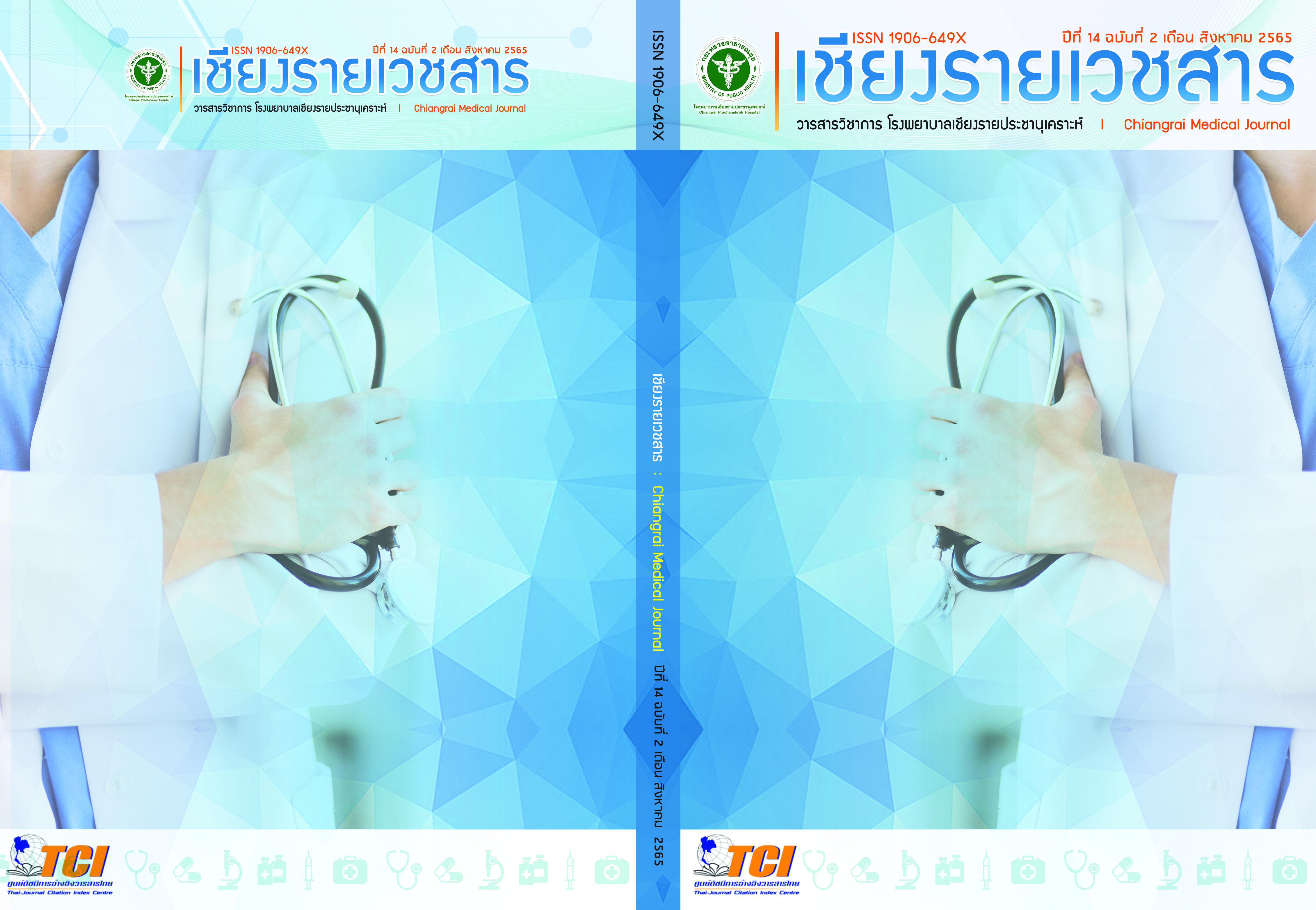ปัจจัยที่ส่งผลต่อพฤติกรรมการใช้ผลิตภัณฑ์สมุนไพรของประชาชน จังหวัดสุโขทัย
Main Article Content
บทคัดย่อ
ความเป็นมา : ประเทศไทยส่งเสริมให้มีการพัฒนาผลิตภัณฑ์สมุนไพรอย่างเป็นระบบและครบวงจรซึ่งจะทำให้ผลิตภัณฑ์สมุนไพรไทยมีความปลอดภัย มีคุณภาพ และมีมาตรฐานเป็นที่ยอมรับในระดับสากล โดยเพิ่มมูลค่าในการส่งออกไปยังต่างประเทศให้มากยิ่งขึ้น ตลอดจนส่งเสริมให้ประชาชนใช้ผลิตภัณฑ์สมุนไพรเพิ่มมากขึ้น
วัตถุประสงค์ : เพื่อศึกษาปัจจัยที่ส่งผลต่อพฤติกรรมการใช้ผลิตภัณฑ์สมุนไพรของประชาชน จังหวัดสุโขทัย
วิธีการศึกษา : การวิจัยเชิงพรรณนาครั้งนี้กลุ่มตัวอย่างเป็นประชาชน จังหวัดสุโขทัย จำนวน 384 คน ได้จากการสุ่มตัวอย่างแบบหลายขั้นตอน เก็บรวบรวมข้อมูลด้วยแบบสอบถามในระหว่างวันที่ 1 พฤษภาคม 2563 ถึงวันที่ 30 มิถุนายน 2563 โดยมีอัตราการตอบกลับแบบสอบถาม ร้อยละ 100.00 ตัวแปรต้นที่ศึกษา ได้แก่ เพศ อายุ ระดับการศึกษา อาชีพ รายได้เฉลี่ยต่อเดือน โรคประจำตัว การใช้อุปกรณ์อิเล็กทรอนิกส์ การได้รับข้อมูลข่าวสารด้านผลิตภัณฑ์สมุนไพร ความรู้เกี่ยวกับผลิตภัณฑ์สมุนไพร ทัศนคติต่อผลิตภัณฑ์สมุนไพร ความพึงพอใจในผลิตภัณฑ์สมุนไพร ส่วนประสมทางการตลาด และความเชื่อมั่นในผลิตภัณฑ์สมุนไพร และตัวแปรตามที่ศึกษาคือ พฤติกรรมการใช้ผลิตภัณฑ์สมุนไพรของประชาชน และวิเคราะห์ข้อมูลด้วยสถิติเชิงพรรณนาและการวิเคราะห์ถดถอยโลจิสติกแบบพหุด้วยวิธีการ forward: LR
ผลการศึกษา : กลุ่มตัวอย่างมีความรู้เกี่ยวกับผลิตภัณฑ์สมุนไพรและความเชื่อมั่นในผลิตภัณฑ์สมุนไพรอยู่ในระดับสูง ทัศนคติต่อผลิตภัณฑ์สมุนไพร ความพึงพอใจในผลิตภัณฑ์สมุนไพร และส่วนประสมทางการตลาดอยู่ในระดับปานกลาง ปัจจัยที่ส่งผลต่อพฤติกรรมการใช้ผลิตภัณฑ์สมุนไพรของประชาชน พบว่า ตัวแปรเพศ โดยเพศหญิงมีโอกาสใช้ผลิตภัณฑ์สมุนไพรมากกว่าเพศชาย 3.769 เท่า (OR = 3.769; 95%CI: 1.524-9.323,
p= 0.004) และตัวแปรโรคประจำตัว โดยประชาชนที่มีโรคประจำตัวมีโอกาสใช้ผลิตภัณฑ์สมุนไพรน้อยกว่าประชาชนที่ไม่มีโรคประจำตัว 0.314 เท่า (OR = 0.314; 95%CI: 0.123-0.797, p= 0.015) ทั้ง 2 ตัวแปรสามารถร่วมกันพยากรณ์พฤติกรรมการใช้ผลิตภัณฑ์สมุนไพรของประชาชนได้ถูกต้องร้อยละ 94.27 อย่างมีนัยสำคัญทางสถิติที่ระดับ 0.05
สรุปและข้อเสนอแนะ : เพศและโรคประจำตัวส่งผลต่อพฤติกรรมการใช้ผลิตภัณฑ์สมุนไพรของประชาชนดังนั้น หน่วยงานที่เกี่ยวข้องควรส่งเสริมและสนับสนุนให้ประชาชนใช้ผลิตภัณฑ์สมุนไพรอย่างต่อเนื่องและสม่ำเสมอโดยมุ่งเน้นการตอบสนองต่อความต้องการตามคุณลักษณะทางประชากรด้านเพศและโรคประจำตัว
Article Details

อนุญาตภายใต้เงื่อนไข Creative Commons Attribution-NonCommercial-NoDerivatives 4.0 International License.
เอกสารอ้างอิง
Constitution of the Kingdom of Thailand, B.E. 2560 (2017). Published in Government Gazette, Vols. 135, Part 40A. (2017 April 6). (in Thai).
Department of Thai Traditional and Alternative Medicine, Ministry of Public Health. The national master plan on Thai herbal development 2017-2021. 2nd ed. Nonthaburi: TS Interprint; 2016. (in Thai)
The National Strategic Plan B.E. 2561-2580 (2018-2037). Published in Government Gazette, Vols. 135, Part 82A. (2018 Oct 13). (in Thai)
Strategy and Planning Division. The national strategic plan for 20 years (Public health). Nontaburi: Office of the Permanent Secretary Ministry of Public Health; 2016. (in Thai)
Herb Products Act B.E. 2562 (2019). Published in Government Gazette, Vols. 136, Part 56A. (2019 April 30). (in Thai).
Ritthiruksa S, Chantraket R, Kittawee S, Sornrung W, Sungsakda M. The policy to support the use of herbal medicines in care units under the Ministry of Public Health. J Thai Trad Alt Med. 2018;16(1):145-57. (in Thai).
Department of Thai Traditional and Alternative Medicine. Health data center Thai traditional medicine service [Internet]. 2020 [cited 2021 April 11]. Available from: http://hs.dtam.moph.go.th/. (in Thai)
Wichantuk P. Knowledge, attitude and behavior of herbal medicinal products used among peoples in Nong Bua Sala village, Mueang district, Nakhon Ratchasima province. J Health Sci. 2019;28(2):244-54. (in Thai)
Jaiyen P, Yeabkai Y. Factors affecting people’s trustworthiness in herbal products in Sukhothai province. J Thai Trad Alt Med. 2020;18(1):122-34. (in Thai)
Intajak T. Herbal used behavior of people in Mueang district, Mae Hong Son province [Internet]. 2021 [cited 2022 Jul 13]. Available from: http://www.cmruir.cmru.ac.th/handle/123456789/2248. (in Thai)
Satsue S, Promponjorn K, Rakpurk W. Survey of factors affecting herbal medicine consumption behavior among people in Sai Noi district, Nonthaburi province. J Thai Trad Alt Med. 2018;16(3):463-73. (in Thai)
Suksai W, Thonglo S, Khummeeseenon D. Preliminary survey of factors affecting the decision to purchase herbal products via social media among teenagers and adolescents in Sai Noi district, Nonthaburi province. J Thai Trad Alt Med. 2018;16(3):449-62. (in Thai)
Wichantuk P. Factors associated with herbal medicinal products use behavior among people in Nong Bua Sala Village, Nakhon Ratchasima province. Journal of Phrapokklao Nursing College. 2020;31(2):12-21. (in Thai)
Pechmanee S, Pechmanee J, Bunchonggleang S, Seesang A, Sithong S. Factors related with herbal consumption behavior of people in Pratuchangtok community, Thaiburi sub-disrtict, Thasala district, Nakhon Si Thammarat province. Journal of Phrapokklao Nursing College. 2021;4(2):5-22. (in Thai)
Bloom BS. The role of the educational sciences in curriculum development. International Journal of Educational Science. 1966;1:5-16.
Kotler P, Keller KL. Marketing management. 15th global ed. Edinburgh: Pearson Education; 2016.
Wheelen TL, Hunger JD. Strategic management and business policy: toward global sustainability. 13th ed. Massachusetts: Pearson Education; 2012.
Morgan RM, Hunt SD. The commitment-trust theory of relationship marketing. J Mark. 1994;58(3):20-38.
The Bureau of Registration Administration, Department of Provincial Administration. Age distribution in Sukhothai province [Internet]. 2021 [cited 2021 April 6]. Available from: https://stat.bora.dopa.go.th/stat/statnew/statINTERNET/#/TableAge. (in Thai)
Daniel WW, Cross CL. Biostatistics: a foundation for analysis in the health sciences. 10th ed. New Jersey: John Wiley & Sons; 2013.
Rovinelli RJ, Hambleton RK. On the use of content specialists in the assessment of criterion-referenced test item validity. Tijdschrift voor Onderwijsresearch. 1977;2(2): 49-60.
Kuder GF, Richardson MW. The theory of the estimation of test reliability. Psychometrika. 1937;2(3):151–60.
Bloom BS. Taxonomy of educational objectives, handbook I: The cognitive domain. New York: David McKay; 1975.
Cronbach LJ. Essentials of psychology and education. New York: McGraw-Hill;1984.
Chainarong W. Factors related to the behavior of using herbs for primary treatment of people in Thanyaburi district, Pathum Thani province (Master’s thesis). Bangkok: Kasetsart University;2011. (in Thai)
Sornsuvit C, Phosuya C, Jaroonvanichkul D, Piriyachananusorn N. Use of herbal and dietary and potential interactions with drugs in patients with chronic diseases. Thai Pharm Health Sci J. 2012;7(4):149-54. (in Thai)
Mattavangkul C, Kawitu K, Sinwannakoo S. Deenoo S, Sinwannakool S. Factor related to herbal use behavior for self-care among people in Phasi-Chareon district. Journal of Nursing, Siam University. 2019;20(39):99-109.
Hennessy S, Bilker WB, Berlin JA, Strom BL. Factors influencing the optimal control-to-case ratio in matched case-control studies. Am J Epidemiol. 1999;149(2):195-7.


